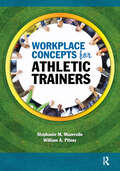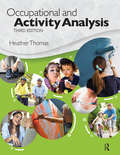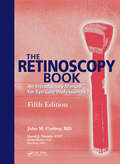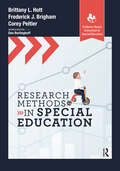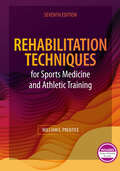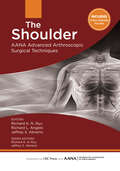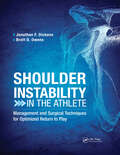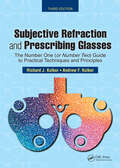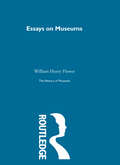- Table View
- List View
Workplace Concepts for Athletic Trainers
by William Pitney Stephanie MazerolleAthletic trainers often find themselves immersed in organizations that can critically influence the way in which they fulfill their professional obligations. The workplace can offer many situations that are challenging, particularly for those athletic trainers who are transitioning into clinical practice.With that in mind, Workplace Concepts for Athletic Trainers provides readers with clear and meaningful information that addresses common concepts and issues that occur in the workplace. The topics selected are a reflection of those covered in the literature as problematic yet identifiable and manageable. Each chapter begins with learning objectives and includes a discussion of the issue itself, how it manifests (sources and antecedents), and strategies and solutions to address the concern.Inside Workplace Concepts for Athletic Trainers, Drs. Stephanie M. Mazerolle and William A. Pitney have infused each chapter with case studies to help readers apply the information presented. The conclusion of each chapter contains a summary, questions for review, and suggested readings to reinforce learning. The recommendations and information presented are designed to improve the workplace culture and climate and provide readers with practical suggestions for dealing with workplace issues.Included with the text are online supplemental materials for faculty use in the classroom.Workplace Concepts for Athletic Trainers is a must-have for any athletic training student transitioning into clinical practice or a clinician seeking help for common issues that occur in the workplace.
Occupational and Activity Analysis
by Heather ThomasNewly updated to reflect the Occupational Therapy Practice Framework: Domain and Process, Fourth Edition (OTPF-4), Occupational and Activity Analysis, Third Edition outlines the process of conducting occupational and activity analyses for occupational therapy students and clinicians.Occupational therapy practitioners use occupations and activities not only as a goal but also as a treatment medium, so understanding both the uniqueness of a client’s occupations and how an activity can be used therapeutically is essential. This text is an introduction to both realms, first by explaining the process by which to peel back the layers of an occupation or activity to reveal its intricacy and then examining how to use this information for evaluation and intervention.Dr. Heather Thomas has updated Occupational and Activity Analysis, Third Edition to reflect the significant changes made to the activity analysis process and terminology in the OTPF-4. Conducting either an occupational or activity analysis investigates not only what is required for full participation but also looks at the meaning ascribed to it by the people, groups, or communities engaging in it and how personal and environmental contexts impact participation.What’s new and included in the Third Edition: Chapters throughout the text have been updated to reflect the changes in the OTPF-4. Updated educational standards set by the Accreditation Council for Occupational Therapy Education (ACOTE) for doctoral and master’s level and occupational therapy assistant programs. Additional cases and relevant clinical examples. Updated tables, boxes, and figures throughout. Expanded section on communication management. Appendices containing updated occupational and activity analysis forms. Example of a full activity analysis. Updated and added photos to help students understand concepts. Included with the text are online supplemental materials for faculty use in the classroom.As a foundational skill, occupational and activity analysis is utilized throughout students’ careers and into their lives as practitioners, making Occupational and Activity Analysis, Third Edition the perfect textbook for the occupational therapy or occupational therapy assistant student, faculty, or clinician.
The Retinoscopy Book: An Introductory Manual for Eye Care Professionals
by John M. CorboyFor over 25 years, The Retinoscopy Book: An Introductory Manual for Eye Care Professionals has been the only basic instruction manual designed specifically to teach the art of clinical retinoscopy. This best-selling classic has been updated and revised to include the latest changes involving the retinoscope, and to meet the developing needs of students in ophthalmology and optometry. Sections on minus cylinders, concave mirror retinoscopy for high refractive errors, and a catalog of instruments have been expanded to reflect the most recent innovations. New sections on retinoscopy after refractive surgery and instrument maintenance are unique to this fifth edition.This text is designed to supplement the Joint Commission on Allied Health Personnel in Ophthalmology (JCAHPO) instruction courses for technicians or to facilitate a do-it-yourself training program for ophthalmology residents, ophthalmic technicians, optometry students, and other eye care professionals in training. Figures and illustrations supplement time-tested exercises to facilitate learning. The user-friendly format prevalent throughout the text enables students to develop a complete understanding of the retinoscope and its many uses.
Research Methods in Special Education (Evidence-Based Instruction in Special Education)
by Brittany Hott Frederick Brigham Corey PeltierResearch Methods in Special Education equips readers with the knowledge needed to make a difference with data. Authors Drs. Brittany L. Hott, Frederick J. Brigham, and Corey Peltier provide access to cutting edge methodologies and related skills researchers need to successfully carry out projects in applied settings. Dedicated chapters focusing on quantitative research synthesis (e.g., meta-analysis, meta-synthesis), single case design, and program evaluation methods allow readers deeply invested in the field of special education to develop a firm foundation, enabling them to ask and answer their socially significant research questions.Written for students in special education teacher prep programs, early career faculty, school administrators, and curriculum specialists, this text includes numerous features that set it apart from other available resources: Dedicated chapters on ethics, establishing effective research partnerships, and evidence-based practice Cutting-edge program evaluation methods and reporting Comprehensive coverage of methods commonly used in special education Detailed information on securing special education funding Case studies, exemplars, resources, and recommendations for additional reading Included with the text are online supplemental materials for faculty use in the classroom. YouTube videos featuring interviews with authors The up-to-date research practices in this text are a valuable addition for educators and researchers serving students with disabilities who have a responsibility to support in-school and post-school outcomes. Research Methods in Special Education gives educators the tools to facilitate a deeper understanding of the research process and evidence-based practice.
Rehabilitation Techniques for Sports Medicine and Athletic Training
by William PrenticeRehabilitation Techniques for Sports Medicine and Athletic Training, Seventh Edition is the definitive reference for athletic training students and professionals who are interested in gaining more in-depth exposure to the theory and practical application of rehabilitation techniques used in a sports medicine environment.Dr. William Prentice and his contributors have combined their knowledge and expertise to produce a single text that encompasses all aspects of sports medicine rehabilitation. Featuring more than 1,000 full-color illustrations, 700 high-resolution videos, and an integrated laboratory manual, this newly updated Seventh Edition provides the athletic trainer with a complete guide to the design, implementation, and supervision of rehabilitation programs for sport-related injuries.The Seventh Edition includes new and updated information on topics including:• Pharmacology and the role of medication in pain management and performance• Nutrition and its impact on rehabilitation• Rehabilitation techniques for the core • Roles within the rehabilitation team• Pathomechanics and epidemiology of common injuries• Psychological considerations and communication with injured patients• Tips for documentation from Dr. Prentice Included with the text are online supplemental materials for faculty use in the classroom.Rehabilitation Techniques for Sports Medicine and Athletic Training, Seventh Editionis a comprehensive resource for athletic training students, faculty, and clinicians; physical therapists who manage rehabilitation programs for sports-related injuries; as well as for strength and conditioning coaches who supervise performance enhancement programs on return to play.
The Shoulder: AANA Advanced Arthroscopic Surgical Techniques (AANA Advanced Arthroscopic Techniques series)
by Jeffrey Abrams Richard Ryu Richard AngeloCo-published with the Arthroscopy Association of North America, The Shoulder: AANA Advanced Arthroscopic Surgical Techniques is a comprehensive technique-based book that presents the latest diagnostic and reconstructive techniques in arthroscopic surgery for the shoulder.The Shoulder: AANA Advanced Arthroscopic Surgical Techniques is authored by premier arthroscopic surgeons Drs. Richard K.N. Ryu, Richard L. Angelo, and Jeffrey S. Abrams, and their international list of expert contributors. This comprehensive resource includes preferred physical examination testing and diagnostic imaging choices in pre-operative planning and patient selection, state-of-the-art step-by-step description of the procedures, detailed surgical equipment lists to perform each procedure, clear and precise indications for surgery and the thoughtful rationale behind stated contraindications, controversial indications, post-operative protocols, and potential complications.The written text is supported by numerous color images and a website with invaluable, narrated video clips depicting disease-specific arthroscopic techniques specific to the shoulder.Features inside The Shoulder: AANA Advanced Arthroscopic Surgical Techniques Narrated video accompanies all surgical techniques, focusing on the stepwise approach to each operation Consistent organization throughout the book results in a bulleted and user-friendly interface for a quick reference or prolonged study Top 5 Technical Pearls for each procedure to enhance outcomes and to avoid common pitfalls and complications High-quality artwork and figures to complement clinical images Equipment and surgical technique checklists for quick reference prior to surgery Each expert contributor was chosen for his or her expertise for a specific topic related to The Shoulder, so the reader benefits by the highest quality and treatment recommendations to provide state-of-the-art care to his or her patient.Some chapter topics include: Arthroscopic Latarjet Stabilization Arthroscopic A-cromioclavicular Joint Reconstruction Arthroscopic Subscapularis Repair: The Extra-Articular Technique Arthroscopic Suprascapular Nerve Release Arthroscopic Suprapectoral Biceps Tenodesis
Shoulder Instability in the Athlete: Management and Surgical Techniques for Optimized Return to Play
by Jonathan Dickens Brett OwensShoulder Instability in the Athlete: Management and Surgical Techniques for Optimized Return to Play is a groundbreaking text that covers all aspects of care for athletes with shoulder instability—from on-the-field management and treatment to successful return to play. Edited by Drs. Jonathan F. Dickens and Brett D. Owens and featuring the expertise of internationally recognized surgeons who specialize in shoulder instability in high-level athletes, Shoulder Instability in the Athlete is a unique collaboration applicable across a variety of professional areas. This will be the premiere reference for physicians, surgeons, therapists, trainers, and students involved in the care of athletes. Each chapter of Shoulder Instability in the Athlete reviews cutting-edge clinical and surgical techniques, as well as outcomes and return to play criteria. In-depth analysis of appropriate literature and outcomes specific to the athlete population are also presented. Important sections within the text include: Principles for the team physician Anterior instability Posterior instability Special topics in instability By focusing specifically on the unique and challenging dilemma of caring for the athlete with shoulder instability, Shoulder Instability in the Athlete will be a valuable reference for all health professionals who manage athletes.
Taping, Wrapping, and Bracing for Athletic Trainers: Functional Methods for Application and Fabrication
by Andy GrubbsFor many years, sports medicine and health care practitioners have used taping and bracing for both the prevention and rehabilitation of injuries; consequently, specific protocols and techniques have evolved to ensure that the results are functional. With numerous methods available for orthopedic injuries, many texts go into all the applications in a given area or injury and leave readers wondering which one works best or is more useful. Taping, Wrapping, and Bracing for Athletic Trainers: Functional Methods for Application and Fabrication is a collection of some of the most commonly used and most functional taping, wrapping, and bracing techniques for orthopedic injuries.Andy Grubbs has designed this text to not only show the best method(s) for a given area but to add another method to each clinician’s bag of tricks. Taping, Wrapping, and Bracing for Athletic Trainers focuses on the most functional and useful methods in clinical settings and each application is performed in the proper manner to ensure functionality. With the step-by-step instructions, athletic trainers, coaches, and allied health care practitioners will gain comprehensive knowledge and practical skills to understand, reproduce and master the useful taping techniques. While this book offers material recommendations for each technique, it is important to understand that some taping techniques can be performed with a number of different types of taping materials.Features: Includes over 300 images Videos accompany each technique to further capture application and assist in technique mastery Covers basic anatomy and common injuries for each body region, as well as casting and splint making techniques Offers material recommendations for each bracing and taping technique Included with the text are online supplemental materials for faculty use in the classroom.Taping, Wrapping, and Bracing for Athletic Trainers: Functional Methods for Application and Fabrication will enhance any athletic training student or clinician’s current techniques along with providing recommended applications for taping and bracing for both prevention and rehabilitation of injuries.
Subjective Refraction and Prescribing Glasses: The Number One (or Number Two) Guide to Practical Techniques and Principles, Third Edition
by Richard KolkerBasic refraction is a foundational part of ophthalmology, and yet beginning ophthalmology residents and ophthalmic technicians are often left on their own to learn the finer points. Despite being core skills, the techniques and practical aspects of subjective refraction and prescribing glasses are often developed by trial and error, if they are developed at all.Subjective Refraction and Prescribing Glasses: The Number One (or Number Two) Guide to Practical Techniques and Principles, Third Edition is designed as a complete guide to those essential skills, offering everything from basic terminology to tips, tricks, and best practices. This updated Third Edition has been expanded in every section with thoughtful, practical advice, and has case scenarios, in a question and answer format, of situations encountered with real-world patients. It is the most comprehensive review of clinical subjective refraction to date. Drs. Richard Kolker and Andrew Kolker together have nearly 50 years of experience in the practice of ophthalmology and bring both the fresh eyes of a beginning ophthalmologist and the experience of a seasoned veteran to this Third Edition. While new residents and technicians will appreciate the thorough explanation of refractive fundamentals, even expert ophthalmologists will appreciate the practical tips that may have never occurred to them. Included are: Very clear, easy-to-read, practical explanations of the subjective refraction process Basic practical optics to explain the steps of subjective refraction The Jackson Cross Cylinder made easy to understand and use Plus and mInus cylinder methods discussed separately and color coded for quick identification An Appendix with a primer on retinoscopy and how to use the manual lensometer The art of subjective refraction and prescribing glasses Subjective Refraction and Prescribing Glasses: The Number One (or Number Two) Guide to Practical Techniques and Principles, Third Edition is the definitive guide to the often neglected skills involved in clinical subjective refraction. Residents and technicians will find it a critical guide in their learning process, but even seasoned ophthalmologists can benefit from the tips and tricks enclosed within.
Potency of the Vernacular Settlements: Recent Scholarships in Vernacular Studies
by Pratyush ShankarThe 11th ISVS (International Seminar for Vernacular Settlements) that was hosted by the School of Environmental Design and Architecture, Navrachana University brought together some important ideas and concerns as related to questions of development at large and vernacular settlements. From questions of ecological balance, use of resources and the way of the pastoral to the ones concerning technology, design and materiality of built environment. The 11th ISVS will be remembered as one that brought whole generation of young and talented scholars in the foreground. Many of them had carried out extensive field work to support their research. The seminar was also remarkable from the point of view of extensive representation of vernacular traditions in different part of the Indian Sub-continent and Southeast Asia along with a range of theoretical concerns.
Potency of the Vernacular Settlements: Recent Scholarships in Vernacular Studies
The 11th ISVS (International Seminar for Vernacular Settlements) that was hosted by the School of Environmental Design and Architecture, Navrachana University brought together some important ideas and concerns as related to questions of development at large and vernacular settlements. From questions of ecological balance, use of resources and the way of the pastoral to the ones concerning technology, design and materiality of built environment. The 11th ISVS will be remembered as one that brought whole generation of young and talented scholars in the foreground. Many of them had carried out extensive field work to support their research. The seminar was also remarkable from the point of view of extensive representation of vernacular traditions in different part of the Indian Sub-continent and Southeast Asia along with a range of theoretical concerns.
DSP 320F28335 Programming
by Majid PakdelThis book provides a comprehensive, practical approach to understanding and implementing the programming concepts of the DSP 320F28335 microcontroller. It is an indispensable guide for both seasoned professionals and beginners interested in mastering the complexities of programmable digital signal processors (DSPs).Inside, you will embark on a journey through the world of DSPs, exploring various programming techniques and strategies tailored specifically for the 320F28335 microcontroller. From the fundamentals of DSP programming to advanced signal processing algorithms, this book covers it all. Each chapter is carefully crafted, offering clear explanations, step-by-step examples, and hands-on exercises to reinforce your learning. You will learn how to harness the power of the 320F28335 microcontroller to develop real-time applications.Whether you are a seasoned programmer looking to expand your knowledge or a beginner ready to dive into the world of DSPs, "DSP 320F28335 Programming"" will be your ultimate companion. With its comprehensive coverage, insightful explanations, and practical examples, this book is a must-have resource for anyone aiming to excel in the realm of digital signal processing programming.
Disruptive Technologies for Sustainable Development
by G. Nagappan V. Uma RaniWe feel greatly honoured to have been assigned the job of organizing the AICTE Sponsored International Conference on Application of AI, ML, DL, Big Data on Recent Societal Issues (ICARSI’2023) on April 21 & April 22,2023 at Saveetha Engineering College. The international conference is a platform that brings together the brightest minds from across the globe to share their ideas and insights on the recent societal issues with Artificial intelligence, Machine Learning, Deep Learning, Big data and emerging technologies. With an aim to promote collaboration and foster innovation, this conference promises to be a melting pot of ideas and knowledge sharing.
Disruptive Technologies for Sustainable Development
We feel greatly honoured to have been assigned the job of organizing the AICTE Sponsored International Conference on Application of AI, ML, DL, Big Data on Recent Societal Issues (ICARSI’2023) on April 21 & April 22,2023 at Saveetha Engineering College. The international conference is a platform that brings together the brightest minds from across the globe to share their ideas and insights on the recent societal issues with Artificial intelligence, Machine Learning, Deep Learning, Big data and emerging technologies. With an aim to promote collaboration and foster innovation, this conference promises to be a melting pot of ideas and knowledge sharing.
The History of Museums Vol 7
by William Henry FlowerMuseums and collecting is now a major area of cultural studies. This selected group of key texts opens the investigation and appreciation of museum history. Edward Edwards, chief pioneer of municipal public libraries, chronicles the founders and early donors to the British Museum. Greenwood and Murray provide informative pictures of the early history of the museum movement. Sir William Flower, Director of the British Museum (Natural History), takes a pioneering philosophical approach to the sphere of natural history in relation to museums. Similarly, Acland and Ruskin discuss and explore the relationships of art and architecture to museums.
The History of Museums Vol 8: Complete Facsimile Of Original 1859 Volume
by John Ruskin Henry W. AclandMuseums and collecting is now a major area of cultural studies. This selected group of key texts opens the investigation and appreciation of museum history. Edward Edwards, chief pioneer of municipal public libraries, chronicles the founders and early donors to the British Museum. Greenwood and Murray provide informative pictures of the early history of the museum movement. Sir William Flower, Director of the British Museum (Natural History), takes a pioneering philosophical approach to the sphere of natural history in relation to museums. Similarly, Acland and Ruskin discuss and explore the relationships of art and architecture to museums.
The History of Museums Vol 7
by William Henry FlowerMuseums and collecting is now a major area of cultural studies. This selected group of key texts opens the investigation and appreciation of museum history. Edward Edwards, chief pioneer of municipal public libraries, chronicles the founders and early donors to the British Museum. Greenwood and Murray provide informative pictures of the early history of the museum movement. Sir William Flower, Director of the British Museum (Natural History), takes a pioneering philosophical approach to the sphere of natural history in relation to museums. Similarly, Acland and Ruskin discuss and explore the relationships of art and architecture to museums.
The History of Museums Vol 8
by John Ruskin Henry W. AclandMuseums and collecting is now a major area of cultural studies. This selected group of key texts opens the investigation and appreciation of museum history. Edward Edwards, chief pioneer of municipal public libraries, chronicles the founders and early donors to the British Museum. Greenwood and Murray provide informative pictures of the early history of the museum movement. Sir William Flower, Director of the British Museum (Natural History), takes a pioneering philosophical approach to the sphere of natural history in relation to museums. Similarly, Acland and Ruskin discuss and explore the relationships of art and architecture to museums.
The History of Museums Vol 6
by Thomas GreenwoodMuseums and collecting is now a major area of cultural studies. This selected group of key texts opens the investigation and appreciation of museum history. Edward Edwards, chief pioneer of municipal public libraries, chronicles the founders and early donors to the British Museum. Greenwood and Murray provide informative pictures of the early history of the museum movement. Sir William Flower, Director of the British Museum (Natural History), takes a pioneering philosophical approach to the sphere of natural history in relation to museums. Similarly, Acland and Ruskin discuss and explore the relationships of art and architecture to museums.
The History of Museums Vol 6
by Thomas GreenwoodMuseums and collecting is now a major area of cultural studies. This selected group of key texts opens the investigation and appreciation of museum history. Edward Edwards, chief pioneer of municipal public libraries, chronicles the founders and early donors to the British Museum. Greenwood and Murray provide informative pictures of the early history of the museum movement. Sir William Flower, Director of the British Museum (Natural History), takes a pioneering philosophical approach to the sphere of natural history in relation to museums. Similarly, Acland and Ruskin discuss and explore the relationships of art and architecture to museums.
The History of Museums Vol 2
by Edward EdwardsMuseums and collecting is now a major area of cultural studies. This selected group of key texts opens the investigation and appreciation of museum history. Edward Edwards, chief pioneer of municipal public libraries, chronicles the founders and early donors to the British Museum. Greenwood and Murray provide informative pictures of the early history of the museum movement. Sir William Flower, Director of the British Museum (Natural History), takes a pioneering philosophical approach to the sphere of natural history in relation to museums. Similarly, Acland and Ruskin discuss and explore the relationships of art and architecture to museums.
The Philosophy of the State and the Practice of Welfare: The Writings of Bernard and Helen Bosanquet
by Bernard Bosanquet Helen BosanquetUnemployment, poverty and the role of the state were themes which structured the discourse of social theory and the developing social legislation in Britain at the end of the Victorian period and the early twentieth century. This collection examines the neglected contribution of Bernard and Helen Bosanquet to that contemporary maelstrom of ideas about the condition of the people, the process of social reform and the practice of social work. Like their contemporaries Sidney and Beatrice Webb, the Bosanquets were a significant partnership integrating philosophy and practice, theory and action. Bernard Bosanquet, the Idealist philosopher, is best known for his study The Philosophical Theory of the State. His wife Helen, economist and social worker, was a member of the Royal Commission on the Poor Laws (1905-9) and between 1909 and 1921, editor of the Charity Organisation Review. Themselves selective supporters of state welfare schemes, they helped to re-fashion the Charity Organisation Society away from its nineteenth century individualism by their advocacy of organic social collectivism. But character, self development and responsibility remained central tenets of their welfare programme. This collection re-publishes most of the Bosanquets' principal books and articles relating to the philosophy of the state and the practice of welfare. The development of their ideas in the context of their own time, and their relevance to current debates in the theory and practice of welfare, forms the basis of a substantial introduction by David Gladstone, the series editor. This volume focuses on the Poor Law.
The History of Museums Vol 2
by Edward EdwardsMuseums and collecting is now a major area of cultural studies. This selected group of key texts opens the investigation and appreciation of museum history. Edward Edwards, chief pioneer of municipal public libraries, chronicles the founders and early donors to the British Museum. Greenwood and Murray provide informative pictures of the early history of the museum movement. Sir William Flower, Director of the British Museum (Natural History), takes a pioneering philosophical approach to the sphere of natural history in relation to museums. Similarly, Acland and Ruskin discuss and explore the relationships of art and architecture to museums.
The Philosophy of the State and the Practice of Welfare: The Writings of Bernard and Helen Bosanquet
by Bernard Bosanquet Helen BosanquetUnemployment, poverty and the role of the state were themes which structured the discourse of social theory and the developing social legislation in Britain at the end of the Victorian period and the early twentieth century. This collection examines the neglected contribution of Bernard and Helen Bosanquet to that contemporary maelstrom of ideas about the condition of the people, the process of social reform and the practice of social work. Like their contemporaries Sidney and Beatrice Webb, the Bosanquets were a significant partnership integrating philosophy and practice, theory and action. Bernard Bosanquet, the Idealist philosopher, is best known for his study The Philosophical Theory of the State. His wife Helen, economist and social worker, was a member of the Royal Commission on the Poor Laws (1905-9) and between 1909 and 1921, editor of the Charity Organisation Review. Themselves selective supporters of state welfare schemes, they helped to re-fashion the Charity Organisation Society away from its nineteenth century individualism by their advocacy of organic social collectivism. But character, self development and responsibility remained central tenets of their welfare programme. This collection re-publishes most of the Bosanquets' principal books and articles relating to the philosophy of the state and the practice of welfare. The development of their ideas in the context of their own time, and their relevance to current debates in the theory and practice of welfare, forms the basis of a substantial introduction by David Gladstone, the series editor. This volume focuses on the Poor Law.
The Philosophy of the State and the Practice of Welfare: The Writings of Bernard and Helen Bosanquet
by Bernard Bosanquet Helen BosanquetUnemployment, poverty and the role of the state were themes which structured the discourse of social theory and the developing social legislation in Britain at the end of the Victorian period and the early twentieth century. This collection examines the neglected contribution of Bernard and Helen Bosanquet to that contemporary maelstrom of ideas about the condition of the people, the process of social reform and the practice of social work. Like their contemporaries Sidney and Beatrice Webb, the Bosanquets were a significant partnership integrating philosophy and practice, theory and action. Bernard Bosanquet, the Idealist philosopher, is best known for his study The Philosophical Theory of the State. His wife Helen, economist and social worker, was a member of the Royal Commission on the Poor Laws (1905-9) and between 1909 and 1921, editor of the Charity Organisation Review. Themselves selective supporters of state welfare schemes, they helped to re-fashion the Charity Organisation Society away from its nineteenth century individualism by their advocacy of organic social collectivism. But character, self development and responsibility remained central tenets of their welfare programme. This collection re-publishes most of the Bosanquets' principal books and articles relating to the philosophy of the state and the practice of welfare. The development of their ideas in the context of their own time, and their relevance to current debates in the theory and practice of welfare, forms the basis of a substantial introduction by David Gladstone, the series editor. This Volume looks at social work and charity.
